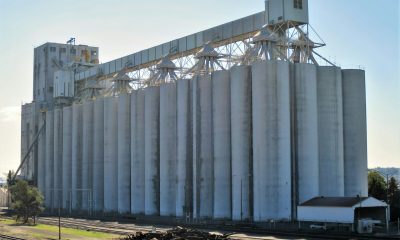Business
Fighting Agri-Food Fraud: How TecnoCientifica’s T-Scanner is Changing the Game
Agri-food fraud is estimated to cost anywhere from $30-40 billion annually. Often involving passing off inferior products as premium products, detecting and combatting the problem requires testing at every step of the supply chain. TecnoCientifica’s T-Scanner offers a breakthrough in real-time grain analysis and could help mitigate the risks in the grain sector of the agri-food industry.

Mention the word fraud, and the first thing to cross most minds will be something ‘financial’. It might be tax fraud, wire fraud, or something else overtly linked with the financial industry. What’s perhaps lesser known is the global agri-food fraud problem that’s currently estimated to be costing consumers and businesses somewhere in the range of $30-$40 billion per year.
Sometimes, the particular methods used to carry out agri-food fraud can be highly sophisticated and may involve complex supply chains, counterfeit documents, and impenetrable networks of shell companies within shell companies. Other times, it might be something as simple as falsely declaring the moisture content of a load of grain.
In any case, the fundamental mechanism in most agri-food fraud generally remains the same. The basic idea is to pass off an inferior product as though it were another, higher-priced product, whether that be sugar syrup-based honey or crude oil-derived vanilla, or simply some over-moist, “overweight” grain.
Fighting Agri-Food Fraud — Easier Said Than Done
In theory, fighting many cases of agri-food fraud should be as simple as sending products out to a laboratory for testing. Comparing the chemical profile of any given crop or product with the markers of a known genuine sample can, in many cases, easily reveal fraud.
Unfortunately, as simple as lab testing for agri-food fraud is in principle, it’s also one of those things that fit neatly into the category of “easier said than done”. With today’s complex supply chains involving numerous exchange points and multiple continents, there are dozens of opportunities for tampering and adulteration on a product’s journey from farm to table.
To give one example, imagine the case of loading grains onto a ship for export, with multiple trucks from multiple grain elevators rolling in, one after the other. While it would be nice to lab test a few dozen samples taken from different points of each inbound truck before offloading it, doing so simply isn’t practical given the time crunches involved. More often than not, an exporter may just have to trust that their suppliers haven’t hidden batches of inferior-quality grains within their loads.
A similar scenario then plays out on the other end once the ship arrives in its destination port. While the exporter may ideally want to take thousands of samples to ensure no rogue loads of sub-par grain were mixed in with their premium order, doing so isn’t always practical. Or, at least, it wasn’t.
Fortunately, as technology advances, so do our abilities to tackle agri-food fraud head-on, even in time-sensitive environments like our example above. What’s more, many innovations coming to market are enabling rapid, on-the-spot testing with minimal capital outlays or disruptions required.
TecnoCientifica’s T-Scanner Joins the Fight Against Argi-Food Fraud
While technology hasn’t fully caught up with all possible avenues for agri-food fraud to take place, there are some fronts that are seeing dramatic progress. One perfect example of this comes from the patented T-Scanner, developed by leading Argentinian AgriTech company TecnoCientifica.
In its primary use case, TecnoCientifica’s T-Scanner is designed to analyze grain samples for properties such as moisture content, protein, starch, and other basic nutritional properties. And, in many ways, it isn’t all that different from the equipment that might be used in a professional laboratory when performing the same analysis on grains — at its base, the T-Scanner is a spectrophotometer that can detect light interactions with matter in the Near-Infrared (NIR) region of the light spectrum.
However, if that’s all the T-Scanner was — a regular NIR spectrophotometer — it wouldn’t be quite so big of a leap in the fight against agri-food fraud as it is. What sets it apart are the innovations TecnoCientifica developed around it. Innovations that not only automate the sampling and analysis process, but also allow it to be integrated directly into existing equipment at facilities receiving truckloads of grains, and to perform its analysis in real-time on grains whilst still loaded on the truck.
Essentially, the T-Scanner brings laboratory-grade analysis — with all of the expected resolution and accuracy — right into the field, and it delivers analysis results almost instantly on the spot. To date, there is no other piece of equipment on the market that comes close.
As for how the T-Scanner is integrated into existing equipment, the particular piece of equipment involved here is what’s known as a truck probe. This is an otherwise simple device that is commonly used for sampling grain loads in trucks and trailers. A hydraulically operated arm dips a probe into the grain, and a vacuum extracts a small sample that can then be analyzed in a laboratory.
TecnoCientifica’s T-Scanner changes this process — instead of extracting samples that then need to be processed by a laboratory, the T-Scanner performs a complete lab-grade analysis on the grain while the probe is still in the truck, in real time. It achieves this by either replacing or complementing the sampling tip with a fiber optic-connected NIR spectrophotometer. This, in turn, is then connected to the ‘brains’ of the T-Scanner, which both performs the analysis and records the data in real-time.
Evidently, an innovation like this represents a huge step forward in the ability to tackle agri-food fraud in the grain industry. Whereas taking multiple samples from each section and level of a load might otherwise be excessively time-consuming, the T-Scanner expedites the entire process such that a full analysis across the entire load becomes not just possible, but considerably more pragmatic, even in the most time-sensitive operations.
Understanding Grain Fraud in the Agri-Food Industry
If TecnoCientifica’s T-Scanner seems like a humble contribution to the global agri-food fraud problem at first, that would be due to a gross underestimation of the sheer scale of grain fraud. While it may be the more expensive or outright luxurious products that capture the most attention — the fraudulent maple syrup, the faked truffle aromas — grain fraud is still a major problem.
While it’s impossible to put a dollar value estimate on it, that’s down to shortcomings in both detection and traceability. However, some individual cases can give some insight into just how large of a problem it is.
In one case of agri-food fraud that hit the grain industry, a Missouri man going by the name of Randy Constant led a scheme passing off non-organic grains as though they were organic. Over the period of 2010-2017, this single instance of agri-food fraud totaled $142 million USD and represented as much as 7-8% of the organic corn and soybeans sold in the United States during the period.
Of course, this particular case of agri-food fraud may be outside the scope of TecnoCientifica’s T-Scanner, which is largely limited to ‘nutritional’ analysis more so than the detection of non-organic practices. However, there are equally common types of grain fraud to which the T-Scanner is perfectly suited.
To give one example here, another common agri-food fraud scheme in the grain industry is misrepresenting the particular varieties or origins of a crop that is being sold. For example, certain varieties of heirloom varieties of corn are known to fetch significant premiums compared to cheaper, more generic varieties.
Detecting this particular type of fraud would rest on the fact that many heirloom varieties of corn often have distinct profiles for moisture, protein, fat, starch, and fiber content — properties that the T-Scanner is able to measure. As such, a simple comparison with known good profiles would instantly confirm whether a particular load contained the variety that was declared.
In another instance of agri-food fraud in the grain industry, the T-Scanner could also be used to detect loads of grains that have been adultered with cheaper grains and/or foreign material. For example, wheat may be diluted with chaff, which generally has significantly different moisture, protein, fat, fiber, and carbohydrate content.
Until Detection Scales Up, Agri-Food Fraud Will Persist
The persistent scale of agri-food fraud is largely to blame on shortcomings in detection. Had Randy Constant’s $142 non-organic grains been detected not only sooner, but also closer to the source, it’s highly unlikely that his scheme would have endured a full seven years. The same applies to many other instances of agri-food fraud. Increased detection at all levels of the supply chain is the only way the industry can ever hope to eliminate the problems.
Unfortunately, there are also hurdles to reaching this state of widespread testing and detection, not the least of which are capital outlays and disruptions to operations that may come with acquiring and installing new equipment. That is if the equipment to do so even exists in the first place.
In this regard, TecnoCientifica’s T-Scanne shines as an example of how innovators in the agri-food industry should be looking to move forward. As a relatively low-cost device that can, to put it crudely, simply be strapped onto existing equipment, the barriers to adoption are incredibly low. In fact, the biggest barrier to adoption may well come from the fact that TecnoCientifica has yet to achieve the global size and reach needed to bring such a device to a global market.
On this front, however, there is some hope — with its intellectual property now in hand, there is nothing stopping TecnoCientifica from reaching out to larger OEMs with a view to integrating the T-Scanner system into other equipment. By simply entering into such licensing agreements, TecnoCientifica and other innovators like it could sidestep the arduous and costly process of building a global manufacturing and support network to ultimately bring its innovations to the agri-food fraud fight much, much faster.
__
(Featured image by John Fiddes (CC BY-SA 2.0) via Geograph.org.uk)
DISCLAIMER: This article was written by a third party contributor and does not reflect the opinion of Born2Invest, its management, staff or its associates. Please review our disclaimer for more information.
This article may include forward-looking statements. These forward-looking statements generally are identified by the words “believe,” “project,” “estimate,” “become,” “plan,” “will,” and similar expressions. These forward-looking statements involve known and unknown risks as well as uncertainties, including those discussed in the following cautionary statements and elsewhere in this article and on this site. Although the Company may believe that its expectations are based on reasonable assumptions, the actual results that the Company may achieve may differ materially from any forward-looking statements, which reflect the opinions of the management of the Company only as of the date hereof. Additionally, please make sure to read these important disclosures.

-

 Markets1 week ago
Markets1 week ago2025 Chaos, Concentration, and the Road to 2026
-

 Biotech1 week ago
Biotech1 week agoAsebio Welcomes the EU Biotech Act as a Boost to Competitiveness and Health Autonomy
-

 Africa2 weeks ago
Africa2 weeks agoBank Al-Maghrib’s Final 2025 Meeting Expected to Maintain Key Interest Rate
-

 Biotech3 days ago
Biotech3 days agoChai Discovery Becomes a Unicorn with $130 Million Series B to Accelerate AI-Driven Drug Design















